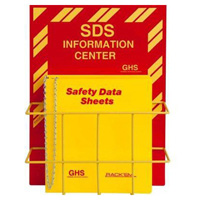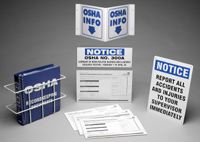| MSDS Topics |
Free Sites | FAQ's | Regulations | Glossary | Software | Suppliers |
| Books | Forum | Poll | Fun stuff | Quiz | Store | |
| MSDS and safety supplies | Search ALL our MSDS info | |||||
 | |||
 |
 |
 |
|
| MSDS Topics |
Free Sites | FAQ's | Regulations | Glossary | Software | Suppliers |
| Books | Forum | Poll | Fun stuff | Quiz | Store | |
| MSDS and safety supplies | Search ALL our MSDS info | |||||
 | |||
 |
 |
 |
|
| Title: CPL 2-2.38D - Inspection Procedures for the Hazard Communication Standard, 1910.1200, 1915.99, 1917.28, 1918.90, 1926.59, 1928.21. | |
| Record Type: Instruction 03/20/1998 | Standard Number: 1910.1200, 1915.99, 1917.28, 1918.90, 1926.59, 1928.21 |
[Note: Annotations made in green text below are tips/commentary by ILPI, not OSHA.]
| This version of the inspection procedures for the OSHA HazCom Standard is no longer valid. It is presented here solely for historical purposes and has been replaced by CPL 02-02-079 effective July 9, 2015. |
Appendix A - Clarifications and Interpretations of the Hazard Communication Standard (HCS)
Appendix B - Sample Letter, MSDS/Label Query
Appendix C - Hazard Evaluation Procedures
Appendix D - Guide For Reviewing MSDS Completeness
Appendix E - Sample Hazard Communication Programs
Index (We deleted the index. Instead, use the Find functionality of your browser instead. If that doesn't find what you want, try the Search box at the top of this page.)
| This version of the inspection procedures for the OSHA HazCom Standard is no longer valid. It is presented here solely for historical purposes and has been replaced by CPL 02-02-079 effective July 9, 2015. |
Note:As far as we can tell, these were the effective dates of previous versions of 2-2.38, all of which are obsolete:

| This version of the inspection procedures for the OSHA HazCom Standard is no longer valid. It is presented here solely for historical purposes and has been replaced by CPL 02-02-079 effective July 9, 2015. |
Documentation. In addition to those items required by the FIRM, when citations are recommended, the CSHO [Compliance Safety and Health Officer] shall document the following on the OSHA-1B or, as appropriate, elsewhere in the case file:
| This version of the inspection procedures for the OSHA HazCom Standard is no longer valid. It is presented here solely for historical purposes and has been replaced by CPL 02-02-079 effective July 9, 2015. |
| See also: Clarifications and Interpretations for Paragraph b (Appendix A) |
(1) The above instruction regarding consumer products cancels and
supersedes the Agency's March 21, 1995, compliance instruction to OSHA
Regional Administrators entitled, "HCS: Documentation of Citations Related to
the Exposure to Hazardous Substances and Consumer Products." This
document is included as Appendix A of OSHA Instruction CPL 2.111.
| This version of the inspection procedures for the OSHA HazCom Standard is no longer valid. It is presented here solely for historical purposes and has been replaced by CPL 02-02-079 effective July 9, 2015. |
| See also: Clarifications and Interpretations for Paragraph d (Appendix A) |
| This version of the inspection procedures for the OSHA HazCom Standard is no longer valid. It is presented here solely for historical purposes and has been replaced by CPL 02-02-079 effective July 9, 2015. |
| See also: Clarifications and Interpretations for Paragraph e (Appendix A) |
The written program should be reviewed first, prior to ascertaining whether the elements of the program have been implemented in the workplace. In general, the written program should consider the following elements, where applicable:
| This version of the inspection procedures for the OSHA HazCom Standard is no longer valid. It is presented here solely for historical purposes and has been replaced by CPL 02-02-079 effective July 9, 2015. |
| See also: Clarifications and Interpretations for Paragraph f (Appendix A) |
| This version of the inspection procedures for the OSHA HazCom Standard is no longer valid. It is presented here solely for historical purposes and has been replaced by CPL 02-02-079 effective July 9, 2015. |
| See also: Clarifications and Interpretations for Paragraph g (Appendix A) |
CSHOs [Compliance Safety and Health Officers] shall evaluate the compliance status of this provision by examining a sample of MSDSs to determine that the MSDSs have been obtained or developed and prepared in accordance with the requirements of paragraphs (g)(2)-(5) of the standard and to ensure that the information regarding the health and physical hazards is accurate. If MSDSs are not updated when new information becomes available, the initial hazard determination performed by the chemical manufacturer or importer is deficient.
Citations shall be issued to the employer only when MSDSs or labels are missing. Citations to manufacturer or importers for incomplete or inaccurate MSDSs or labels shall include an abatement requirement for the transmittal of corrected MSDSs or labels to all customers with the next shipment of the chemical.
| This version of the inspection procedures for the OSHA HazCom Standard is no longer valid. It is presented here solely for historical purposes and has been replaced by CPL 02-02-079 effective July 9, 2015. |
| See also: Clarifications and Interpretations for Paragraph h (Appendix A) |
Training programs must be evaluated through program review and discussion with management and employees.
If no form of employee training has been provided, citations shall be issued under (h)(1). Citations shall be issued under paragraph (h)(2) and (h)(3) of the standard, as appropriate, if there is a deficiency in an otherwise existing program. The employer is always ultimately responsible for ensuring that employees are adequately trained, regardless of the method relied upon to comply with the training requirements.
| This version of the inspection procedures for the OSHA HazCom Standard is no longer valid. It is presented here solely for historical purposes and has been replaced by CPL 02-02-079 effective July 9, 2015. |
| See also: Clarifications and Interpretations for Paragraph i (Appendix A) |
CSHOs [Compliance Safety and Health Officers] evaluating MSDS and hazard determination programs may request disclosure of trade secret identities under paragraph (i)(12) of the HCS. OSHA shall take all steps feasible to protect trade secret identities, including secure filing and return of information when its use is complete.
| This version of the inspection procedures for the OSHA HazCom Standard is no longer valid. It is presented here solely for historical purposes and has been replaced by CPL 02-02-079 effective July 9, 2015. |

| This version of the inspection procedures for the OSHA HazCom Standard is no longer valid. It is presented here solely for historical purposes and has been replaced by CPL 02-02-079 effective July 9, 2015. |
The official, public domain, OSHA version of this document is available at https://www.osha.gov/pls/oshaweb/owadisp.show_document?p_id=1551&p_table=DIRECTIVES.